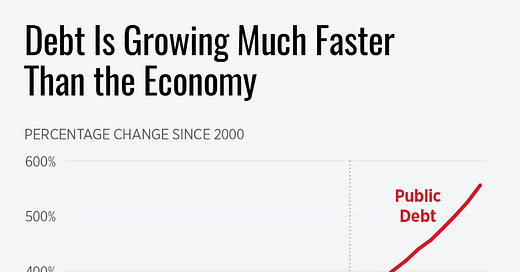Debt Digest | Entitlement Math, Debt Blame Game, and Loose Money Fuels Crisis Risks
Links & Fiscal Facts
Here are this week’s reading links and fiscal facts:
The math doesn’t add up on Biden’s entitlement plan. In both the State of the Union and elsewhere, the president has promised to block reductions to Social Security and Medicare benefits while increasing taxes on high-income earners. According to the Manhattan Institute’s Brian Riedl, Biden’s tax hikes will fail to make these programs solvent. Optimistically, new revenue would only deliver an extra 4 percent of gross domestic product as trust fund shortfalls reach 6 percent of GDP by 2052. Instead, “Congress could close as much as two-thirds of the Social Security and Medicare shortfalls by increasing program eligibility ages and paring back the growth of benefits for non-poor retirees,” he argues.
The Debt Blame Game: Whodunnit? The Mercatus Center’s Charles Blahous writes that partisan fights over who is responsible for the mounting national debt are both unhelpful and usually based on inaccurate claims. Three-fifths of the worsening fiscal deficit is due to the enactment of federal health care programs, Medicare and Medicaid, and expansions of Social Security between 1965 to 1972. “All policy decisions combined over the last 50 years have not contributed as much to the widening fiscal gap as the decisions made in those few eventful years,” he writes. Boccia discusses how bipartisan commissions can overcome political gridlock here.
Loose money policies fuel crisis risks. A new working paper reviews 150 years of macro-financial data and argues “a loose stance of monetary policy predicts the emergence of credit market overheating in post-WWII advanced economies both in the household and in the business sector…[which are] important short-term early warning signals for crisis risk.” Attempting to return to perpetually low interest rates is unsustainable and has severe fiscal implications. Boccia and I argue that high and rising debt increases the likelihood of elevated interest rates and sudden fiscal crisis. Read more about the high costs of debt here.
Debt limit debates spur budget reform. The Peterson Foundation highlights current and past proposals which pair debt ceiling increases with significant fiscal reforms. Over the last 50 years, major legislation included “significant deficit reduction, key fiscal discipline rules like PAYGO, and budget process reform” including spending caps and bipartisan commissions. Boccia covers negotiating at the debt limit in more detail here and here.
Debt outpaces economic growth. The Heritage Foundation’s Preston Brashers calls attention to budget milestones which illustrate a worsening fiscal trajectory. Among them, the debt will have grown about eight times faster than the economy over a 20-year period, beginning in 2007 to 2027, considering current projections by the Congressional Budget Office (see the chart below). Boccia and I review CBO’s budget and economic projections in more detail here.




